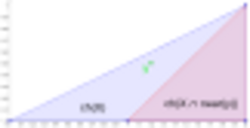Integrally convex set
An integrally convex set is the discrete geometry analogue of the concept of convex set in geometry. A subset X of the integer grid [math]\displaystyle{ \mathbb{Z}^n }[/math] is integrally convex if any point y in the convex hull of X can be expressed as a convex combination of the points of X that are "near" y, where "near" means that the distance between each two coordinates is less than 1.[1]
Definitions
Let X be a subset of [math]\displaystyle{ \mathbb{Z}^n }[/math].
Denote by ch(X) the convex hull of X. Note that ch(X) is a subset of [math]\displaystyle{ \mathbb{R}^n }[/math], since it contains all the real points that are convex combinations of the integer points in X.
For any point y in [math]\displaystyle{ \mathbb{R}^n }[/math], denote near(y) := {z in [math]\displaystyle{ \mathbb{Z}^n }[/math] | |zi - yi| < 1 for all i in {1,...,n} }. These are the integer points that are considered "nearby" to the real point y.
A subset X of [math]\displaystyle{ \mathbb{Z}^n }[/math] is called integrally convex if every point y in ch(X) is also in ch(X ∩ near(y)).[2]
Example
Let n = 2 and let X = { (0,0), (1,0), (2,0), (2,1) }. Its convex hull ch(X) contains, for example, the point y = (1.2, 0.5).
The integer points nearby y are near(y) = {(1,0), (2,0), (1,1), (2,1) }. So X ∩ near(y) = {(1,0), (2,0), (2,1)}. But y is not in ch(X ∩ near(y)). See image at the right.
Therefore X is not integrally convex.[1]
In contrast, the set Y = { (0,0), (1,0), (2,0), (1,1), (2,1) } is integrally convex.
Properties
Iimura, Murota and Tamura[3] have shown the following property of integrally convex set.
Let [math]\displaystyle{ X\subset \mathbb{Z}^n }[/math] be a finite integrally convex set. There exists a triangulation of ch(X) that is integral, i.e.:
- The vertices of the triangulation are the vertices of X;
- The vertices of every simplex of the triangulation lie in the same "cell" (hypercube of side-length 1) of the integer grid [math]\displaystyle{ \mathbb{Z}^n }[/math].
The example set X is not integrally convex, and indeed ch(X) does not admit an integral triangulation: every triangulation of ch(X), either has to add vertices not in X, or has to include simplices that are not contained in a single cell.
In contrast, the set Y = { (0,0), (1,0), (2,0), (1,1), (2,1) } is integrally convex, and indeed admits an integral triangulation, e.g. with the three simplices {(0,0),(1,0),(1,1)} and {(1,0),(2,0),(2,1)} and {(1,0),(1,1),(2,1)}. See image at the right.
References
- ↑ Jump up to: 1.0 1.1 Yang, Zaifu (2009-12-01). "Discrete fixed point analysis and its applications" (in en). Journal of Fixed Point Theory and Applications 6 (2): 351–371. doi:10.1007/s11784-009-0130-9. ISSN 1661-7746.
- ↑ Chen, Xi; Deng, Xiaotie (2006). "A Simplicial Approach for Discrete Fixed Point Theorems". in Chen, Danny Z.; Lee, D. T. (in en). Computing and Combinatorics. Lecture Notes in Computer Science. 4112. Berlin, Heidelberg: Springer. pp. 3–12. doi:10.1007/11809678_3. ISBN 978-3-540-36926-4.
- ↑ Iimura, Takuya; Murota, Kazuo; Tamura, Akihisa (2005-12-01). "Discrete fixed point theorem reconsidered" (in en). Journal of Mathematical Economics 41 (8): 1030–1036. doi:10.1016/j.jmateco.2005.03.001. ISSN 0304-4068. http://www.kurims.kyoto-u.ac.jp/preprint/file/RIMS1449.pdf.
 |



